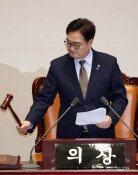Unclear directions and timeline for denuclearization
Unclear directions and timeline for denuclearization
Posted June. 15, 2018 09:28,
Updated June. 15, 2018 09:28
Visiting Seoul to brief South Korean President Moon Jae-in on the result of the June 12 summit meeting between U.S. President Donald Trump and North Korean leader Kim Jong Un, U.S. Secretary of State Mike Pompeo explained that Kim wants to achieve something significant at a very fast pace. Before the briefing, Pompeo said Washington hoped to achieve major disarmament by Pyongyang in two years and a half or within the first term of President Trump. This is the first time that a high-ranking U.S. official has publicly announced a timeline for Pyongyang’s denuclearization.
It remains unclear as to what Pompeo means by “major disarmament.” When a reporter used the expression “major nuclear disarmament,” the secretary of state repeated after the reporter, saying he is “hopeful we can achieve something like that.” This must bear some relevance with the comment that Kim Jong Un made in Singapore that the world will witness a “major change.” It might refer to a drastic “front loading” measure whereby the regime will have its nuclear warheads and ICBMs shipped out to foreign countries. Whatever the term actually means, however, it looks like the measure will clearly fall short of a “complete nuclear dismantlement,” including nuclear weapons, materials, facilities and capabilities.
So far, the Trump administration has emphasized the importance of taking a swift, “all-in-one” implementation. Subsequently, it has been expected that taking nuclear weapons from Pyongyang and completely dismantling them will take about six months and two years, respectively. Following the Singapore summit, however, the plan is turning into a “denuclearization that consumes a significant amount of time,” getting closer to the form of “phased, simultaneous actions,” a principle espoused by North Korea. Some might call it a realistic approach, factoring in the amount of time needed for technological implementations for denuclearization and legislative procedures to guarantee the regime’s security. Either way, the timing for complete denuclearization has been put off significantly.
This naturally adds to the suspicion that the United States is putting the denuclearization agenda on the back burner, focusing too much on the dismantlement of ICBMs, a more immediate threat for the country. Pompeo expressed an optimistic view on Pyongyang’s potential, swift actions for denuclearization, saying that the sanctions against the North will not be lifted until a complete denuclearization is verified. But it is unreasonable to expect Pyongyang to take actions voluntarily when there is no deadline imposed. “It is an incredibly valuable achievement that we’ve escaped the threats of war, nuclear and long-range missiles,” said President Moon, but we will be exposed to nuclear threats until a complete denuclearization is achieved on the Korean Peninsula. This is why we need to keep our eyes wide open to the follow-up meeting between Pyongyang and Washington.
klimt@donga.com







